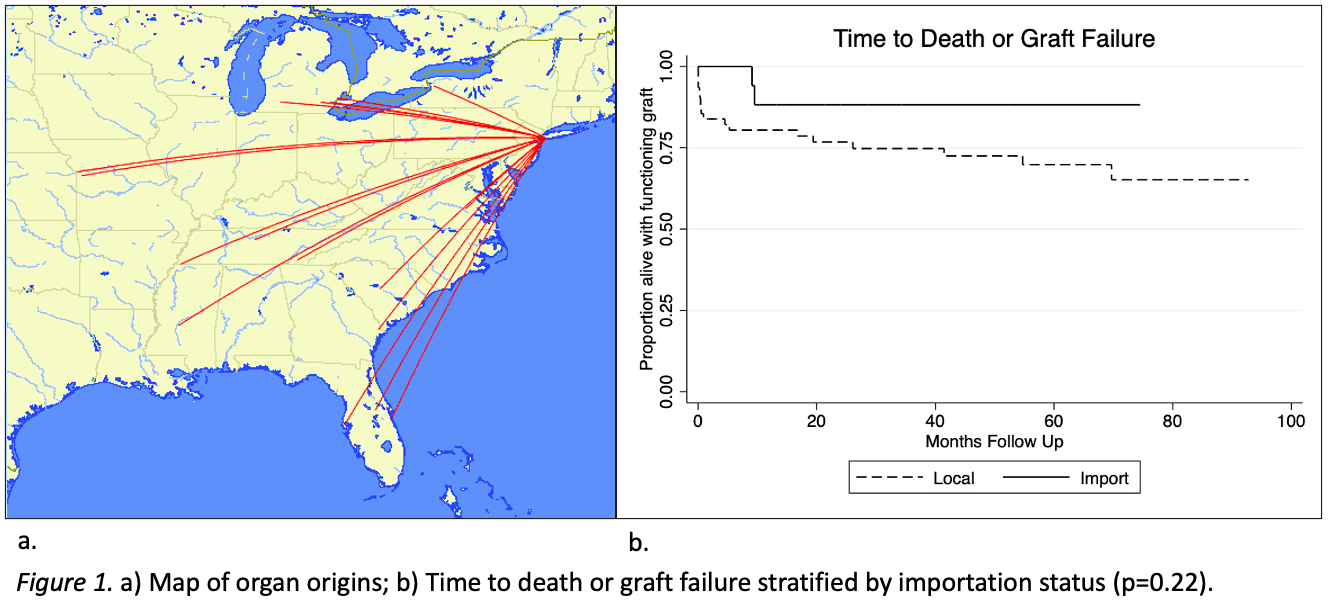When Pancreata Fly: Excellent Results from Long Distance Imported Pancreas Allografts
Department of Surgery, Columbia University College of Physicians and Surgeons, New York, NY
Meeting: 2022 American Transplant Congress
Abstract number: 1148
Keywords: Organ Selection/Allocation, Outcome, Pancreas, Pancreas transplantation
Topic: Clinical Science » Pancreas » 65 - Pancreas and Islet: All Topics
Session Information
Session Name: Pancreas and Islet: All Topics
Session Type: Poster Abstract
Date: Sunday, June 5, 2022
Session Time: 7:00pm-8:00pm
 Presentation Time: 7:00pm-8:00pm
Presentation Time: 7:00pm-8:00pm
Location: Hynes Halls C & D
*Purpose: To address long waitlist times and increase pancreas transplantation in a competitive donor service area, our center has adopted a protocol for long distance importation of pancreata procured by surgeons unaffiliated with our center. Here we analyze our outcomes.
*Methods: We conducted a retrospective review of pancreas transplantation at our institution from January 1, 2014, the start of our importation program, through September 30, 2021. All patients who underwent simultaneous kidney pancreas transplant (SPK), pancreas after kidney transplant (PAK), pancreas transplant alone (PTA) and pancreas after SPK were included. Outcomes were compared between locally procured grafts and imported grafts, which were defined as grafts procured greater than 250 nautical miles (NM) from our center.
*Results: 81 patients underwent pancreas transplantation during the study time period, 19 (23.5%) received imported grafts. Average distance of import was 644.2±233.8 NM. None of the imported grafts were procured by the receiving center. There were no significant differences in age, sex, or Type 1 versus Type 2 diabetes between recipients of imported versus locally procured organs. There was no significant difference in proportion of SPK, PAK, PTA or pancreas after SPK. There was no significant difference in donor age. 10 (52.6%) of imported grafts and 15 (24.2%) of local grafts were from donors < 18 years old (p = 0.025). Imported graft donors weighed less than local donors (52.36±38.41 vs 67.13±16.67kg, p = 0.01). A significantly higher proportion of imported grafts came from donors weighing < 30kg (26.32% vs 3.23%, p = 0.007). Cold ischemic time was longer for imported grafts than for local grafts (13.44±2.25 hr vs 9.79±2.18 hr, p < 0.001). There were no deaths or graft losses within 30 days in the import group. In the local group there was 1 (1.61%) death within 30 days, 5 (8.1%) required pancreatectomy for thrombosis, and 4 (6.5%) required pancreatectomy for other complications. There were no deaths or graft losses following transplant from donors weighing < 30kg in either group. Differences in 30-day and late death and graft loss were not significant between groups.
*Conclusions: We obtained excellent results from pancreata transported from great distances despite procurement by surgeons unaffiliated with our center, longer cold times and use of organs from donors generally considered high risk, such as pediatric donors weighing <30kg. Centers should consider expanding criteria for acceptance of imported pancreata to increase numbers of transplants and combat organ discard.
To cite this abstract in AMA style:
Owen-Simon N, Dube G, Sandoval P, Ratner L, McCune K. When Pancreata Fly: Excellent Results from Long Distance Imported Pancreas Allografts [abstract]. Am J Transplant. 2022; 22 (suppl 3). https://atcmeetingabstracts.com/abstract/when-pancreata-fly-excellent-results-from-long-distance-imported-pancreas-allografts/. Accessed January 2, 2026.« Back to 2022 American Transplant Congress

